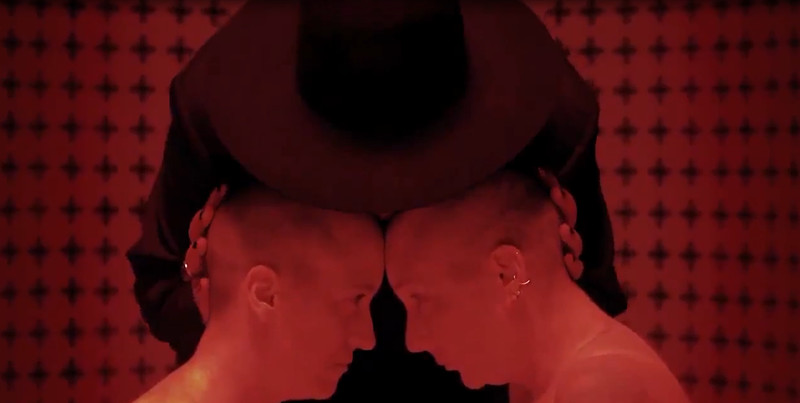
What the heck is a fantasy film? Well it can be kind of confusing because we often associate fantasy with the sci-fi genre. While sci-fi often tries to ground itself into some type of scientific fact, fantasy does not.
The fantasy film genre can be defined as something that includes imaginative or fantastic themes. It may include magic, myths and legends, swords and sorcery, folklore, fairytales, supernatural events, and fantasy worlds.
Some of the films may just contain an element of fantasy placed in a natural world, while others may have a highly developed fantasy world that is like nothing we have seen or know to be real. Probably the most well known fantasy series in fiction and film is J.R.R. Tolkiens The Lord of the Rings series, but there are so many more from this film genre that can be traced all the way back to the silent era.
The earliest silent film examples of the fantasy genre come from French film creator Georges Melies, whose most famous film of these was A Trip to the Moon from 1902. It is a fantastic tale about a group of explorers who travel to the moon and discover a group of people that live underground, and is most memorable for the iconic scene where the spaceship flies into the eye of the moon.
Since then, the fantasy world has been a theme often revisited in films and has been very successful. The 1930’s saw big films such as King Kong, The Wizard of Oz, and the Tarzan series. Versions of Beauty and the Beast and The Jungle Book were created in the 1940’s.
The 1950’s saw the animated world of Alice in Wonderland and the beginning of the Greek mythology told with Hercules, along with a series of Arabian stories about Sinbad.
The popularity of the mythology and sword and sorcery films continued straight into the 1980’s, where it exploded in popularity with the Conan series, Excalibur, Legend, Willow and others. More fantasy based films continued to follow like The Neverending Story, Princess Bride, Big Trouble in Little China, Dark Crystal, and the Highlander series.
The popularity of the fantasy genre continues to do well with Films like The Lord of the Rings and the television show Game of Thrones. Along the way, there have been many films made on the cheap in order to piggyback off the success of these various films. So this list is a combination that falls somewhere in the middle of that; some where successful, and some are a mix of knockoffs and forgottens that along the way have gained a cult following.
1. Die Nibelungen (1924)
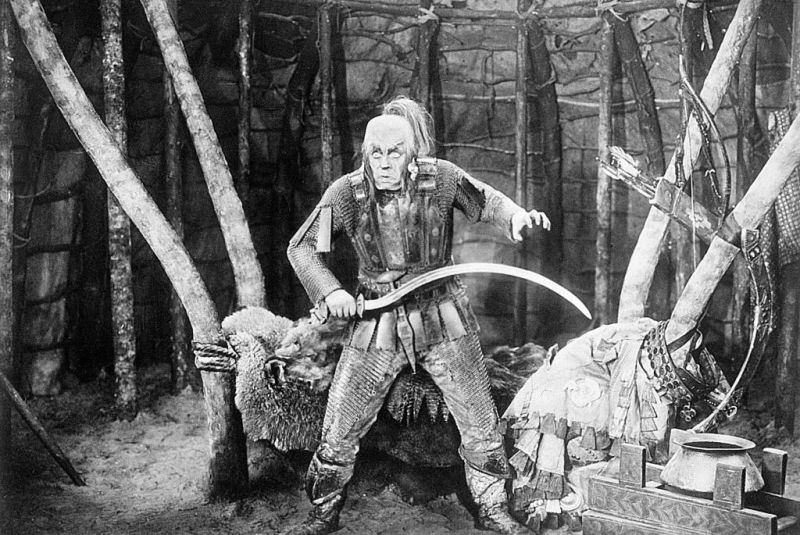
This is an early German epic directed by Fritz Lang and based upon an old upon an old Germanic poem, from around the 13th century. Lang is one of the great masters of early German cinema, creating Metropolis, M, and the Dr. Mabuse series. He would eventually end up in Hollywood and is mostly known there for his film noirs such as The Big Heat.
This film was done as a two parts and each part is around 145 minutes, so it is pretty long. Because of the total length of both of them the plot is pretty lengthy, so we will have to keep it short. Siegfried is the son of a king and goes on a journey to win the heart of a Princess Kriemhild, along the way he slays a dragon and kills a dwarf king to become King of the Realm of Nibelungen.
His realm has twelve kings and one of the queens lies to her about losing her virginity to Kriemhild, so her husband will kill him. Siegfried is murdered and Kriemhild swears to avenge his death. The second part of the film deals with Kriemhild going for vengeance.
This really is an epic in every way, with some amazing scenes and effects for the era. It was a huge “architectural concept from beginning to end, and it was a triumph of studio craftsmanship at which the Germans excelled. The castles, the forests, the brooks and caverns were all studio-made” [1].
There is an amazing handcrafted dragon and battle scene that rivals the later works done by special effects maverick Willis O’Brien, such as King Kong. There is also a great transformation scene when Siegfried dies, in which a tree next to him turns into a skull.
If you’re a fan of Fritz Lang, silent films, or the fantasy genre, then you should give this a chance despite the length of it.
2. The Thief of Bagdad (1940)
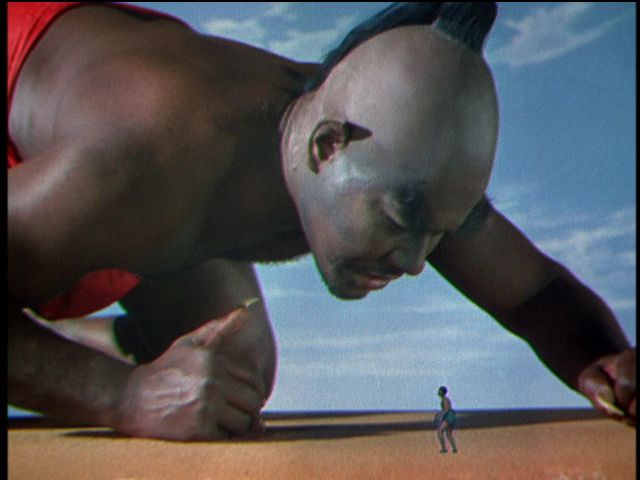
“GIGANTIC! The Wonder Picture of All Time!” [2]. This is basically the story that eventually inspired the animated Disney film Aladdin. It is based upon a book with the same title, written by Achmed Abdullah, and also borrows elements from the One Thousand and One Night stories. A version was also made as a silent film in 1924, starring Douglas Fairbanks.
The story involves Prince Ahmad, who has been tricked by Jaffar and thrown into a dungeon. He joins forces with a thief named Abu and they go on a series of adventures in order to stop Jaffar and save the princess. This includes a Djinni in a bottle, giant spiders, a magic flying carpet, an all seeing magic jewel, a mechanical horse, and a many armed mechanical dancing statue.
This is a pretty great film for the era, especially for the special effects. It was “one of the most elaborate and costly fantasy films made until that time” [3]. It went on to win three Academy Awards, Best Cinematography, Best Art Direction and Best Special Effects. The effects that were used were ground breaking at the time, including the use of a hanging matte painting in front of the camera.
Roger Ebert said that this film is “one of the greatest of fantasy films, on a level with The Wizard of Oz” [4]. This film was popular when it came out, but has been somewhat been forgotten except among cult fans. If you have kids, or are a fan of fantasy or the history of special effects, then this is one that you need to watch.
3. Loves of Hercules (1960)
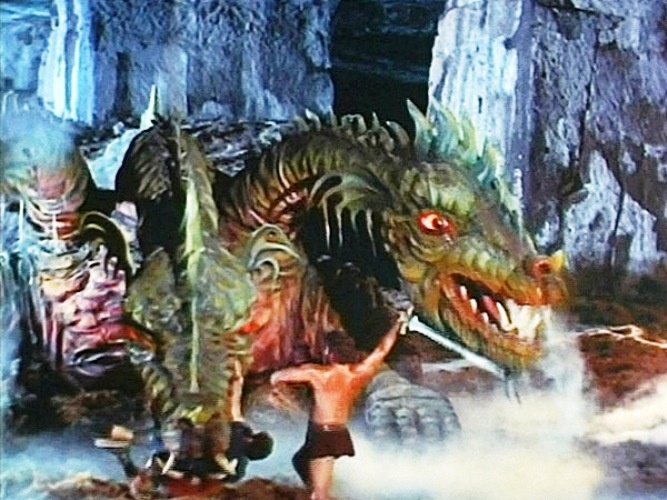
This was an Italian production looking to profit off of the success of Hercules (1957), while also luring some English acting talent to help distinguish it from the rest. The English stars in this one are Jayne Mansfield and her husband Mickey Hargitay. Mansfield agreed to do this film on the condition that her husband plays the role of Hercules [5].
Hercules village and wife are killed in a plot performed by Licos in order to gain rule over Ecalia. Licos kills the King of Ecalia and blames it on Deianira, so Hercules will take his revenge on her. Hercules ends up falling in love with Deianira, while dealing with additional schemes that Licos hatches up in order to frame Hercules for murder.
This is a fairly well produced low budget sword and sandals film. It is most notable because of Jayne Mansfield’s appearance, who was a Hollywood sex symbol in the 1950’s and early 1960’s. She was pregnant during production of this film, and had to diet in order to conceal the pregnancy. The film has a few memorable action scenes; Hercules fights a wild bull, an ape, and a Hydra dragon.
4. Atlas (1961)
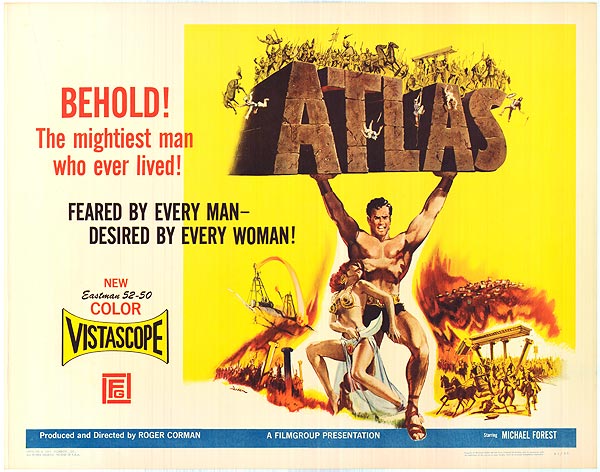
“BEHOLD! The mightiest man who ever lived!” [6]. This is a low budget film from the king of low budgets, director Roger Corman. Greek mythological superhero Atlas fights for King Praximedes until he discovers his evil nature and then turns to fight against him.
Corman was also hoping to piggyback off the success of Hercules (1957) and other sword and sandal films. Originally hoping to film completely in Greece, that fell through and he had to shoot some sequences at UCLA to double for Greek structures [7]. They also had plans for 500 soldiers in costumes and were only able to get 50 [7]. Because it was partially shot in Greece, there is a lot of dubbing like it is a Euro production.
This is worth seeing for the comedic dialogue and if you’re a fan of Corman and the cheep drive-in movies.
5. Seven Faces of Dr. Lao (1963)
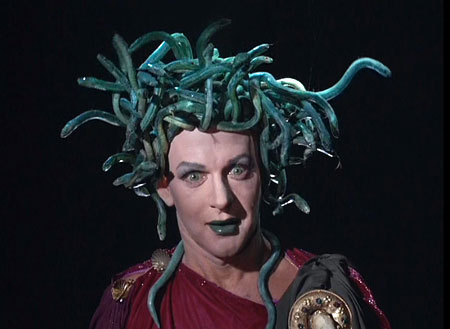
“Which face will the wily doctor reveal to you?” [8]. An ancient Chinese man (Tony Randall) brings his mysterious circus to the town of Abalone, Arizona. There he changes the townspeople forever by showing their reflections with the use of his circus characters, including the abominable snowman, Merlin the magician, Apollonius, Pan, Medusa, and a giant serpent. The story was adapted from a 1935 novel titled The Circus of Dr. Lao, written by Charles G. Finney.
The film was directed by George Pal, a fantasy film maverick who also did The Time Machine, Tom Thumb, Atlantis, the Lost Continent, The Wonderful World of the Brothers Grimm, and a series of cartoons known as The Puppetoons during the 1940’s.
Tony Randall is probably best remembered for starring on the TV series The Odd Couple in the 1970’s, but he also starred in several movies during the 1960’s. Barbara Eden also makes an appearance, she is best known for playing the lead role on the TV series I Dream of Jeannie.
The director and makeup head William Tuttle passed on selecting Peter Sellers, Donald O’Connor, and Peter Ustinov for the lead role; because they needed someone who could successfully change into seven different characters under heavy makeup [9].
Tuttle would go on to win an honorary Oscar for his makeup work on this film, the only other time this occurred was for Planet of the Apes (1968) [9]. Randall had to shave his head for the film, in order to easily apply the make up for the different characters [8].
This falls somewhere in line with Wizard of Oz and Willy Wonka and the Chocolate Factory, mixing humor and darkness into a family oriented film. It’s a funny movie, with a strong story and great special effects. Tony Randall really shines in this performance, even though he’s completely in make up the whole time.
The only time he’s recognizable is at times when his character purposely changes his voice and it sounds like him. He amazingly morphs into all seven characters and uses even more vocal changes, going through various dialects throughout the movie.
The film was a box office disappointment, but has gained a strong cult following among sci-fi and fantasy fans, and also fans of the director [8]. You should check this out if you’re a fan of fantasy or any of the films listed above.
6. Jason and the Argonauts (1963)
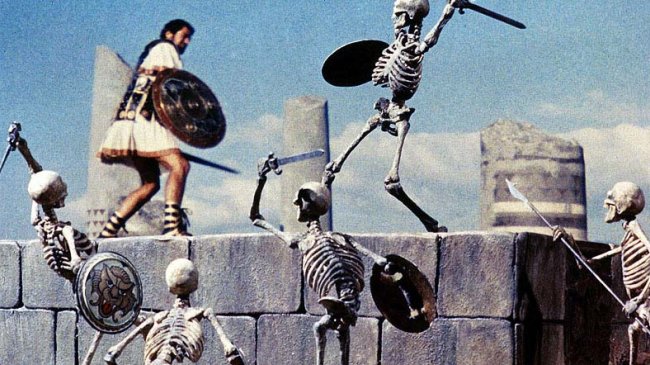
“Greatest Odyssey Of The Ages – for the first time on the screen” [10]. This is the tale of Jason, heir to the throne of Thessaly. Pelias takes the throne when he is a boy at the command of the god Zeus, murdering his father and sisters.
Pelias kills one of Jason’s sisters in the Goddess Hera’s temple, this angers Hera and she becomes Jason’s protector. Hera’s prophecy is that the person that obtains the Golden Fleece will defeat Pelias, she also warns him of a man with one sandal. Twenty years later Jason saves Pelias from drowning and in the process looses a sandal.
Realizing who he is, Pelias convinces Jason to go on the quest for the Golden Fleece in the hopes that he is killed in his attempt. Jason forms a group called the Argonauts to join him on his quest, including Hercules, Hylas, and Acastas (son of Pelias). On their journey, they come across Harpies, a giant bronze Talos, a Hydra, and an animated skeleton army.
The acting is adequate in this, but what really stand out are the colors, settings, music, and special effects. It was filmed in Eastman color and there are vibrant colors throughout it. They filmed on location in various parts of Italy, which provided for interesting and lavish settings such as the decayed building on the island of the Harpies.
The music was scored by Bernard Herrmann and performed by the Sinfonia orchestra of London. Herrmann had composed the music for many well known films such as Citizen Kane, Psycho, Taxi Driver, and several other films with special effects man Ray Harryhausen.
The special effects were created by renowned stop motion special effects wizard Ray Harryhausen, which really stands out in this film. Harryhausen is known for doing stop motion special effects on Mighty Joe Young, The Beast From 20,000 Fathoms, It Came From Beneath the Sea, 20 Million Miles to Earth, The Three Worlds of Gulliver, a series of Sinbad movies, along with others.
He is considered one of the greats of special effects and had a ton of influence on the artists that would come after him. Basically all of the memorable scenes in the film involve his stop motion effects. There is a great scene with the tall bronze statue of Talos battling the Argonauts and grabbing their ship and breaking it apart.
Then there’s the Argonauts battling two Harpies and capturing them in a net. Then an excellent scene where Triton comes out of the water to hold the rocks from falling so the Argonaut’s ship could pass. And finally, there is a battle with Hydra and a skeleton army. The skeleton army would be recreated in Army of Darkness thirty years later, yet the original version looks just as good and possibly better then the new one.
The film did pretty well domestically, with a reported gross of $2,100,000 versus a $1,000,000 budget [10]. It has continued to grow a cult following among fantasy film fans, sword and sandal film fans, and fans of Harryhausen and stop motion animation. If you’re a fan of any of those, then this is a must see.
7. Santa Claus Conquers the Martians (1964)
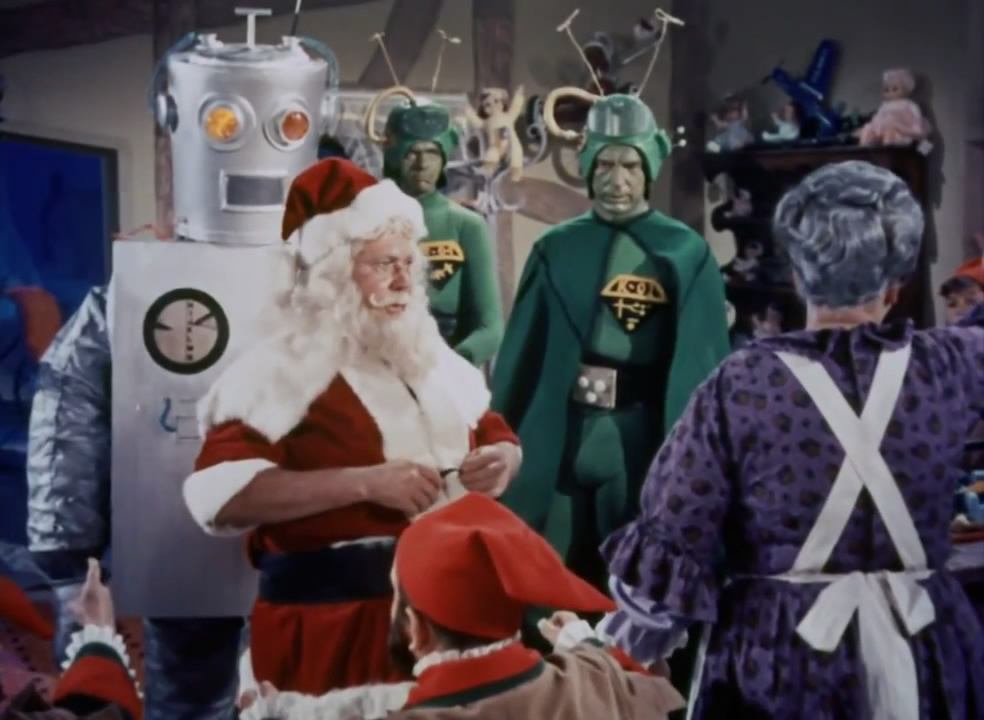
“Santa Kidnapped by the Martians! Out-of-this-world fun ‘n’ action…as two Earth Kids are whisked away with him to Mars!” [11]. This is the essence of what a low budget drive in movie is; you’ll either hate it or embrace and love the fact that it’s a great bad film.
Filmed on a budget of around $200,000, it was meant to be a movie for kids during the holiday season that watched Howdy-Doody and the programs from Disney [12]. The story involves the kidnapping of Santa and two earth children by men from Mars, in the hopes of cheering up their children who do not have a Santa.
This is just the best of the worst, especially if you love cheesiness. Full of bad dialogue, cheep sets and Martian outfits, fake mustaches, a cardboard robot, and of course Santa. This is just hilarious; Kind of like the TV movie KISS Meets the Phantom of the Park. It was featured on season 3, episode 21 of Mystery Science Theater 3000.
This is a cult favorite because of the fact that it’s one of the cheaply made drive-in movies. So if you love those types of films and are looking for a good laugh, then you have to see this.
8. The Trip (1967)
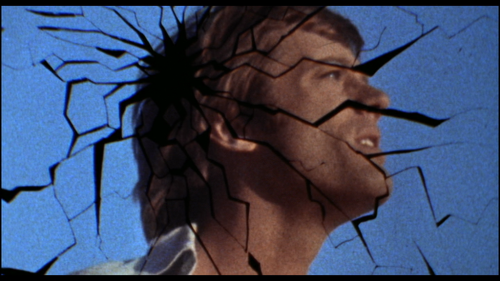
“Groovy Gravy!…The Trip is Out of Sight!” [13]. This is a fantasy film that focuses on the fantasy world that is experienced through the use of drugs. A television director Paul Groves (Peter Fonda) decides to take an LSD trip in order to expand his understanding of his life and where it’s going.
Dennis Hopper plays his drug dealer and Bruce Dern plays his acid trip tour guide. The viewer goes on the acid trip journey with Paul as he has visions of flashing colors and shapes, sexual encounters, death, hooded riders on horses, witches, a dwarf, dancing girls, another dwarf on a carousel, a torture chamber and a trippy soundtrack. We go back and forth between what he’s envisioning in his mind versus how we see his trip from the outside.
This was directed by Roger Corman and was mostly written by Jack Nicholson. It’s notable for several reasons. One, because of the large amount of future talent, Hopper, Fonda, and Nicholson would later go on to star in the popular counter culture film Easy Rider (1969).
Second, this was the first of the psychedelic films to make it onto the mass market, marking the slow transition “of the rebel story from a Beat relic into its hippie incarnation as Easy Rider” [14]. They even make sure to show copies of On the Road by Jack Kerouac and Howl by Allen Ginsberg in the house that he takes the acid; both authors were considered to be part of the Beat Generation.
It tries to play more like a cautionary tale with a warning at the beginning, similar to Reefer Madness (1936) and the other cautionary tale movies of that era.
It was filmed around the Sunset Strip that passes through West Hollywood, California on a budget of around $100,000 [15]. It was a huge success, earning somewhere around $10,000,000 [15].
This a very well made film for the budget and features very good performances from its future stars. It has continued to have a strong cult following mostly among fans of psychedelic subgenre, drive-in film fans, and fans of the director and actors.
If you like any of those types of films or the actors then you should check this one out. If you like this, then other films that may interest you are Head, Easy Rider, Psych-out, Performance, Holy Mountain, The Wall, Fear and Loathing in Las Vegas, and Enter the Void.